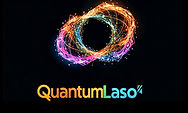From Oklahoma City to Quantum-Enhanced Drug Discovery 🧬💊
- mansour ansari

- Sep 30
- 3 min read
So, last year—right after the Christmas holidays—I set out on a new journey. As a retired software guy, I didn’t want to sit idle. I wanted to build something useful. Something that, in my golden years, could carry value for humanity.
That journey led me into the world of quantum random number generators (QRNGs)—tiny devices in USB or PCIe format that don’t just simulate randomness, but harvest it directly from nature. After discovering the technology from CryptaLabs, I was determined to put it to work.
I built a pipeline to harvest and upload quantum entropy keys—billions of bits of pure unpredictability generated by photon polarization at the hardware level. These entropy keys are securely stored in a Google Cloud bucket, and from there, they flow into the applications I’m developing across physics, chemistry, meteorology, and—most importantly now—drug discovery.
In my QuantumTornado project, I feed QRNG entropy side by side with classical pseudorandom numbers into tornado forecasting simulations. The differences are striking—QRNG reveals collapse zones and vorticity patterns that PRNG consistently misses.
Building on that foundation, I developed QuantumCURE, my drug discovery stack. Here, QRNG entropy is injected into protein–ligand docking simulations. By expanding the search space beyond deterministic baselines, QRNG uncovers novel binding poses and affinities that could easily be overlooked in traditional pipelines. When combined with AI and soon multi-omics integration, this creates what I believe is the foundation of a quantum-enhanced discovery factory in a box.
This is only the beginning. With further scaling, deeper quantum hooks (IonQ, D-Wave), and extended AI/omics integration, this platform has the potential to compete with—and even complement—the work of large labs.
A year and thousands of hours later, I stand here with a working system powered by CryptaLabs QCicada hardware. Without their innovation in QRNGs, my vision would never have come this far.
I’m proud of what’s been built, and even more excited about where it’s heading.

So, now, I’m excited to share a breakthrough I’ve been working on for the past year: QuantumCURE, a live platform that combines AutoDock Vina molecular docking, quantum entropy injection, and AI-driven omics analysis—running right now on Google Cloud.
What makes this unique?
🔹 Real compounds (PubChem)
🔹 Real proteins (PDB, like EGFR for lung cancer)
🔹 Real docking (AutoDock Vina on Cloud Run)
🔹 Quantum randomness (QRNG + cloud entropy) guiding simulations beyond classical limits
This isn’t a mock-up. It’s already processed over 460,000 compounds—showing binding affinities, collapse patterns, confidence scoring, and even symbolic glyphs representing quantum collapse signatures.
Why does it matter? Traditional drug discovery is slow and costly, often missing hidden leads. By introducing quantum entropy and AI, we’re exploring chemical spaces pharma ignores. The same physics used by billion-dollar labs is now being extended with quantum hooks for deeper discovery.
📈 Next step: Scaling. We’re seeking capital infusion and partnerships to extend docking engines, integrate D-Wave/IonQ, and expand into multi-omics + AI LLM analysis for oncology and beyond.
👉 Oklahoma can be a hub for quantum biotech—and I believe this is the right moment to bring it forward.
If you’re curious, collaborating, or investing, let’s talk.📧 videomover@gmail.com
#DrugDiscovery #QuantumComputing #AI #Biotech #Innovation #Oklahoma#cryptalabs # Quantum Drug Discovery # Omics # D-Wave #IonQ
Thank you




Comments